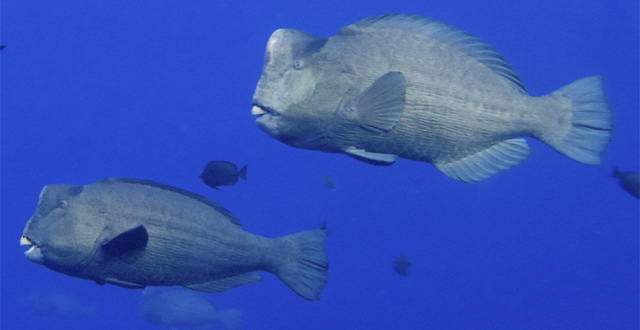Interactions
This species
may be threatened but the list of predators is very minimal. Sharks
and humans are the only major predators for the Green Humphead
Parrotfish (Encyclopedia of life 2009). Many sharks like the
Scalloped
Hammerhead Shark, and Some parrotfish have been
known to change colors as they try to defer the predator away
(Encyclopedia of life 2009). Commercial fishing as well as spearing
fishing are both huge in decreasing the population of this fish
(Arkive 2008). Refer to Endangerment page
for more details. Some parrotfish eject off a nasty mucus at night to
worn off predators, like the shark, while the fish rests
(Encyclopedia of life 2009). The mucus is bad smelling and tasting
to defer the predator away at night. Some also will hide and rest in
caves at night. This slime on some parrotfish can be poisonous for
other fish as well as humans if consumed and can be fatal
(Encyclopedia of Life 2009). In places like the Bahamas the scales from some types of
parrotfish can be used for decoration or artwork (Encyclopedia of
life 2009). The Green Humphead Parrotfish can be consumed, but
mentioned earlier, the skin and meat can be poisonous to humans.
In contrast
this large fish preys on many other organisms. All parrotfish in
general prey on the organisms in these major clades: Porifera,
Cnidaria, and Anthozoa (Encyclopedia of life 2009). The main food
sources for the Green Humphead Parrotfish are the benthic algae and
coral, making them omnivores (Donaldson et al. 2004). The Green Humphead Parrotfish eats
about two to five tons of coral per year (Dulvy et al. 2006). The
coral and parrotfish have a mutualistic relationship while the
parrotfish is getting food by feeding off of the coral the coral is
also benefitting because the parrotfish is eating off the algae that
is growing on the coral (Encyclopedia of life 2009). By eating the
algae off the coral, this keeps the algae from taking over the coral
reefs. The coral is a very hard solid substance and takes a special
mechanism to be eaten. This being the case the Humphead Parrotfish
does not have much for competition for food. Specialized teeth are
attached to the top jaw of the fish. These teeth are molded together
to make one solid row which looks like a parrot’s beak, hence the
name parrotfish (Encyclopedia of life 2009). These teeth are very
tough because they have to break down pieces of coral. For a
phylogenetic tree showing teeth and jaw modifications please visit
our Classification page.The giant
hump on the forehead is also very tough as it is used to break apart the coral. There are
also teeth in the back of the throat to fully break down the coral
for digestion to be able to take place. Not all of the coral
sediment is digested leaving some to come out of the feces (Arkive
2008).
To navigate to our home page simply press
Home located at the bottom of every page, or continue to the
Endangerment page.
